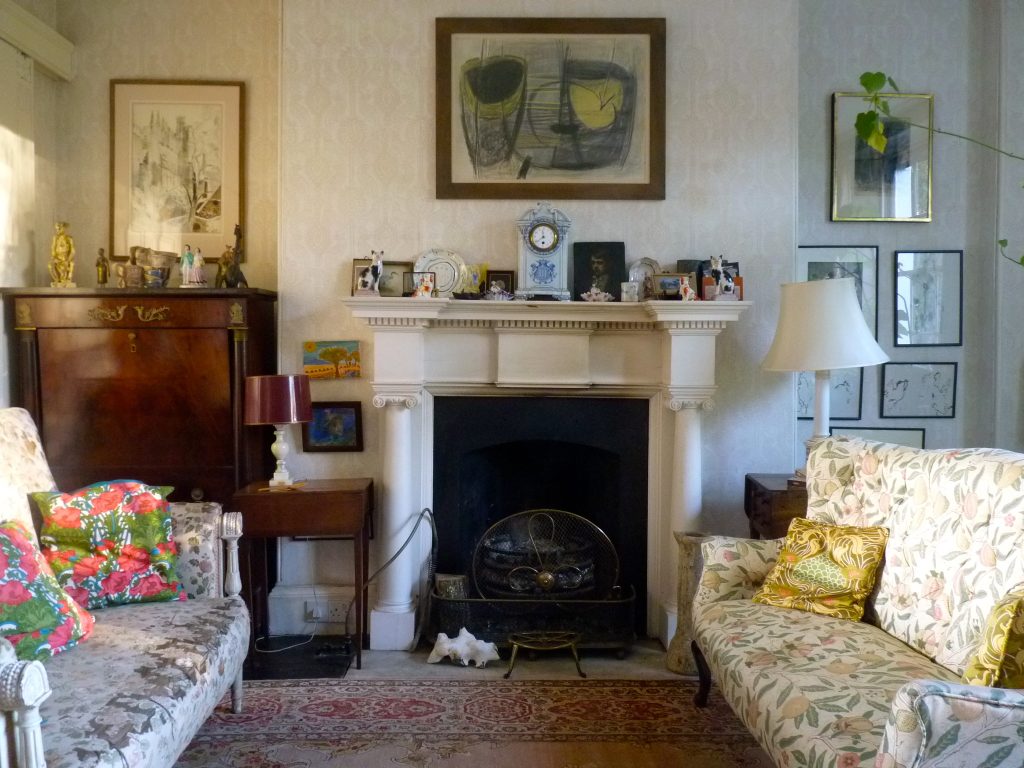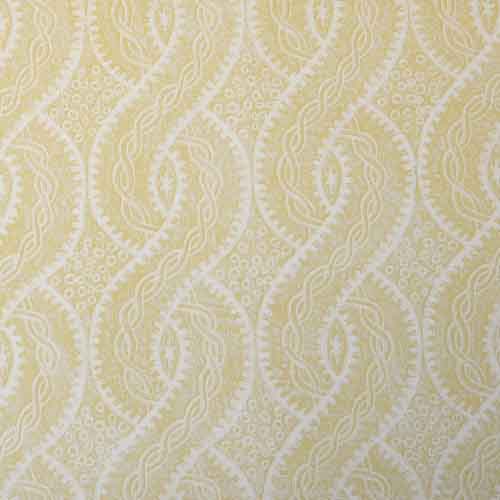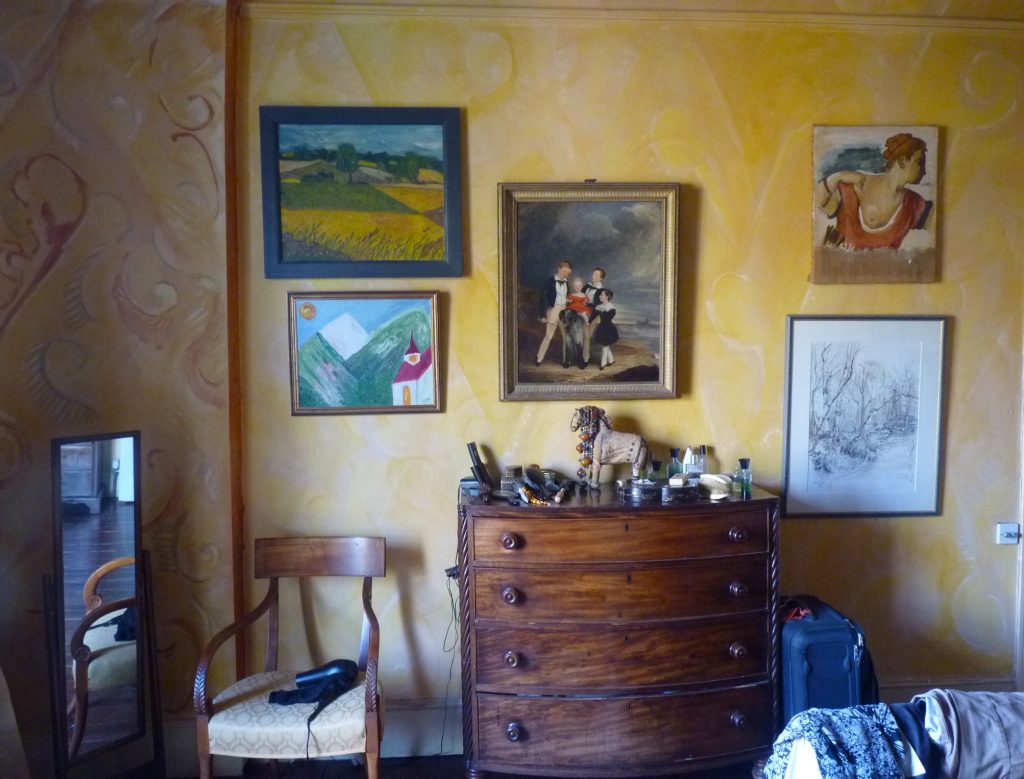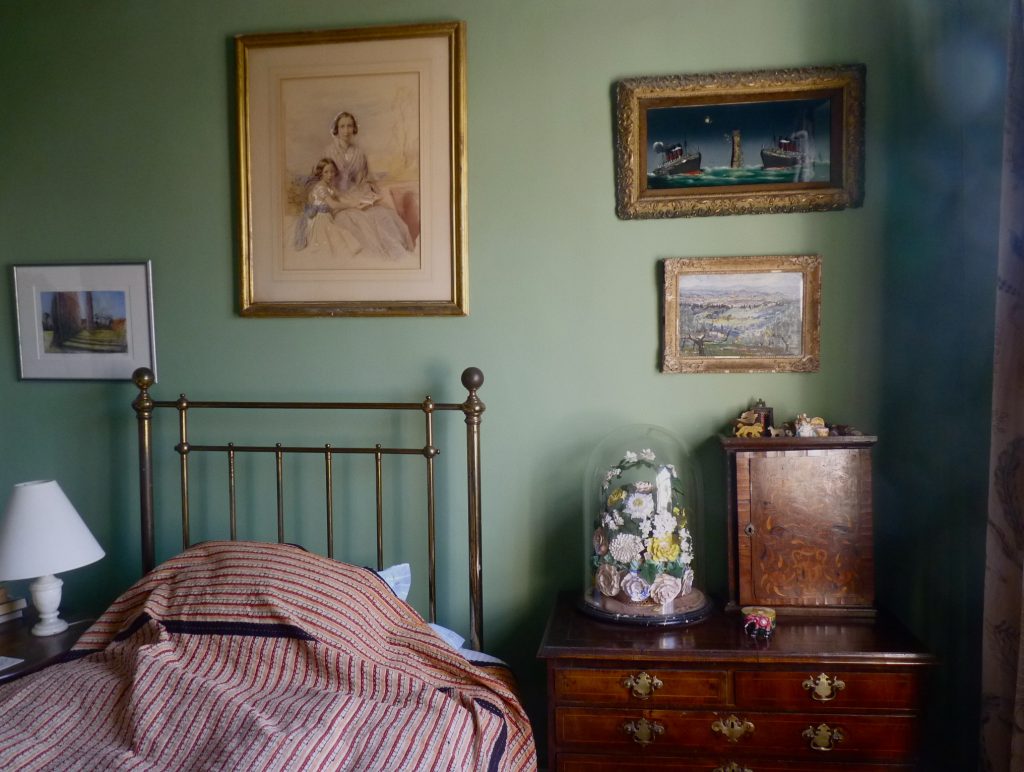Tanya Harrod published ‘The Real Thing, essays on making in the modern world,’ this week. Its essays are about art, craft and design, and the shifts and spaces in between them.These are subjects she has been thinking and writing about for 30 years. In this book you can read about the taxonomy of the rubbish dump, Barbara Hepworth’s missing archives, Eric Gill, Folk nationalism and reviving ‘peasant art’ in Britain, and on page 86, ‘Why don’t we hate Etsy?’

The house which she shares with her husband Henry Harrod in west London is a palimpsest, containing the belongings and decorative finishes from three generations. Henry’s paternal grandmother Frances Forbes Robertson made her home here in the 1930s, the portraits that she painted hang together in the staircase and hall. Next came her son the economist Sir Henry Roy Forbes Harrod and his energetic and strong minded wife Wilhelmina Cresswell (always known as Billa), aesthete and historian who was briefly engaged to the poet John Betjeman, complied the Shell Guide to Norfolk for him, founded the Norfolk Churches Trust and made her last home in the Old Rectory, Holt, in that interesting county. She died in 2005. Tanya’s things are C19th Arundel prints and twentieth century paintings and ceramics, almost all of them by artists and makers about whom she has written. On the Biedermier tallboy is a ceramic Madonna and Child by contemporary artist-craftsman Philip Eglin, of whom Tanya writes in The Real Thing, ‘Studying my Madonna and Child reminds me of how learned good artists invariably are.’

‘Beasties’ Wallpaper by Peggy Angus (1904-1983), designer, teacher and painter, of whom Tanya wrote this obituary when she died in 1993. The painted plate is by Philip Eglin. (You can buy Angus’s papers once again now, from Anne Dubbs at the wonderful Blithfield and Company.)

The oil painting on the left is by Tanya’s mother Maria Sax, who painted her own mother on horseback galloping away from her two small, distraught children.

Large jars by Richard Batterham, Dorset artist-potter who trained at Leach’s studio and follows the tradition of Michael Cardew and William Staite Murray. In her essay, ‘Heroes with Feats of Clay,‘ Tanya discusses the vexed question of why avant-garde sculptural ceramics haven’t achieved the same high status as abstract sculpture : ‘There may be yet another sticking point for many people. Western art, despite the hiccup of abstraction, is firmly rooted in literature and narrative. Most pots have no easily understood narrative content. They are, as Herbert Read was aware, marvellous examples of pure form. This self-contained remoteness …has come to seem problematic. There is a famous story about a student talking to the eminent designer David Pye. The student said that ceramics did not excite him at all. ‘Did it ever occur to you,’ asked Pye, ‘that their function might be to calm you down?’

A Zimmerlinde, a large leaved Austrian Linden or Lime tree cultivated as an indoor plant. Lucian Freud had one of these, it appears in his ‘Large Interior, Paddington‘ 1968-9, and several of his drawings.

‘Billa’s table.’ Her country house was anatomised and photographed for Alvilde Lees-Milne’s book,’The Englishwoman’s House’ in 1984.

Small ornaments that she arranged on its hardstone top . ‘We all liked her table so much, so we decided to recreate it.’

Tanya’s first subject was John Ruskin and the Arundel Society, the fons et origo of all her writings since on the arts and the crafts. Ruskin’s ‘cabinet of wonders’ combing visual art, natural history collections and manuscripts made for his ideal society The Guild of St. George, is still on show at the Ruskin Gallery in Sheffield. Some of the nineteenth century prints of Italian Renaissance paintings published by the Society and collected by her as a postgraduate student hang in the hall, against crimson ‘Suns’ wallpaper designed by Peggy Angus and hand printed using lino-cut blocks and household emulsion in her Camden Town studio.Tanya’s essays on ‘Peggy Angus and flat pattern’ and ‘William Morris in our time,’ are published in her new book, The Real Thing.

Hanging higher up the stairs beneath Tanya’s ancestors, are portraits of the young Roy Harrod painted by his adoring mother, some of them returned again to London from the Old Rectory in Holt.

A painting by Stella Cardew, first wife to the composer Cornelius Cardew. Tanya’s biography of his potter father Michael, is ‘The Last Sane Man,‘ published in 2013. A. S. Byatt described her as ‘the perfect biographer for such a complex and gifted man,’ you can read her review here.

Peggy Angus’s original hand-blocked bathroom wallpaper,made in her Camden Town studio. As Tanya has written,
‘The beauty of her handblock papers has been recognised above all by artists; partly because unlike most wallpapers they form the ideal background to paintings. Over the years Angus invented an extraordinary range of patterns. Many were abstract but others convey a vivid pastoral mood, making subtle use of oak leaves, heraldic dogs and birds, grapes and vines, corn stooks, stylised suns and winds. They seem rooted in the natural world and in the visual arts of the British Isles, from Celtic pattern to heraldry to the art of bargees and gypsies.’

Sailor’s tokens and shell souvenirs collected by Billa Harrod hang above the bath.They represent the kind of popular ‘folk’ or ‘people’s’ art beloved of the artist Barbara Jones, of whom I wrote in an earlier post.

The same ‘TWIST’ pattern in a yellow colourway, printed by Blithfield and Co.

The kitchen overmantle. Drawing by their little granddaughter, a bird plate made by Seth Cardew at Wenfordbridge Pottery and assorted ceramics amassed by earlier generations of Harrods.

‘The Future is Handmade : the crafts in the new millennium,’ poster advertising Tanya’s lecture in Krakow.

Large bowl by Michael Cardew, two small apprentice pieces made by Tanya at the Wenfordbridge Pottery under the tuition of Seth Cardew, and her masterpiece biography of his father Michael Cardew, which won the James Tait Black Memorial Prize.

Father and daughter. The Crafts in Britain in the 20th Century, her outstanding magnum opus published by Yale in 1999, and its beautiful offspring, The Real Thing now a 5 star read on Amazon. Its essays were written from the 1980s on, charting the period in which we changed from being a nation of producers to become a nation of consumers, as the centres of mass production moved to the far side of the world and the internet created a new virtual world of ‘infinite images.’

Tanya possesses the visual objectivity and academic rigor of the architectural scholar Nicholas Pevsner, but this is overlaid with a sensibility and humanity that makes her writing so much more nuanced, rewarding and pleasurable to read.
All images (3 portrait photographs and Blithfield’s TWIST excepted) c.bibleofbritishtaste.










never fails to excite me ,wonderful.
This is such a beautiful house. I love the history. I am going to try to get some of Tanya’s books to read over here in the USA. Your blog is such a gem. I look forward to every post. Thank you.
Such a wonderful post! I love the ornaments dotted around Tanya’s home, especially those delightful shell pictures.
It is delightful to see the details of a life enchanted by meaningful things and by sharing the ideas that come with them in the world. I have had the pleasure to meet Tanya several times in Canada and once in Britain. In the final photograph she is resting her arm on a ‘sujuni’ cushion from Bihar, India from Sujuni Mahila Jeevan (Stitching Women’s Lives). All “things’ are connected in circles.